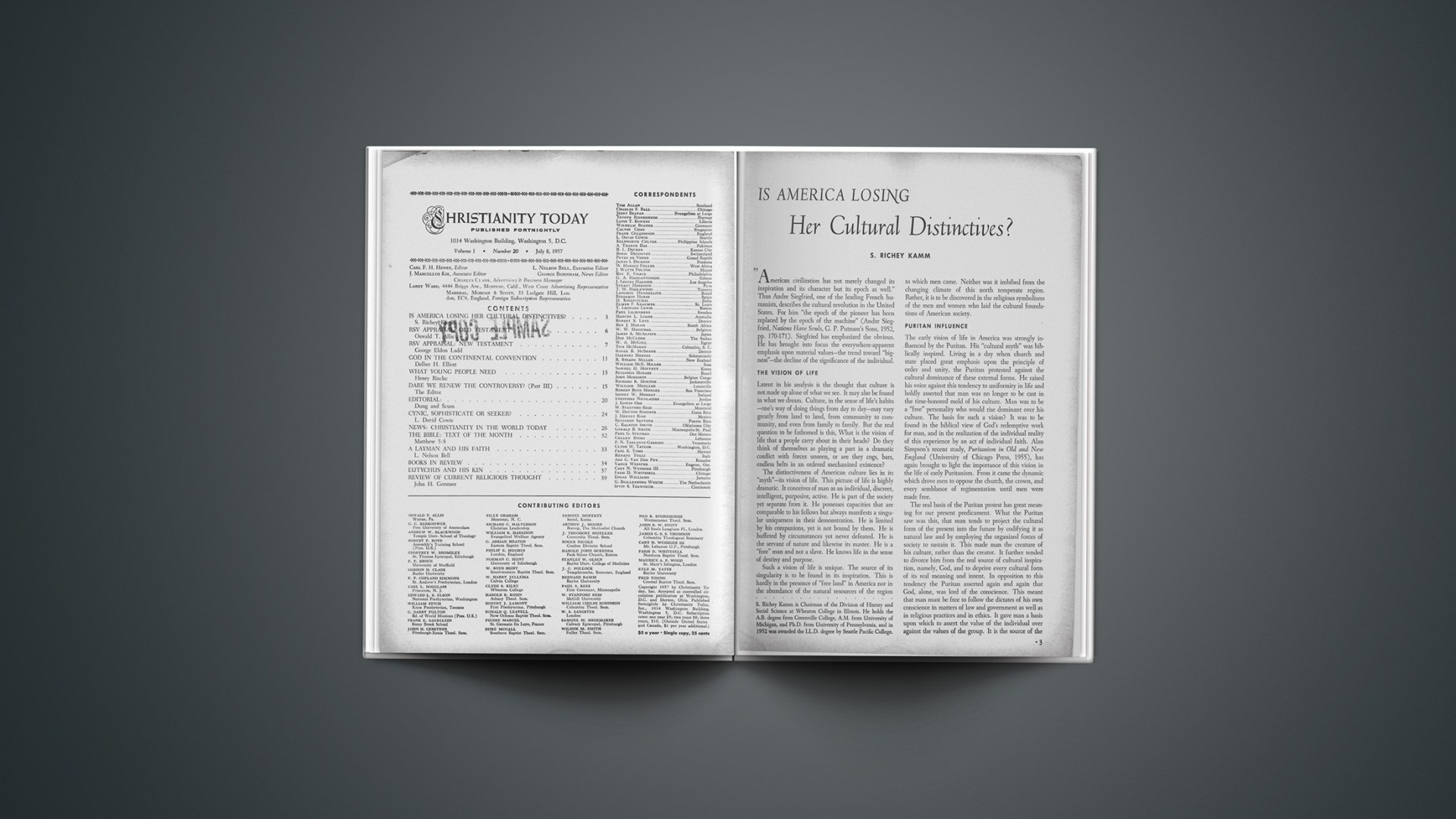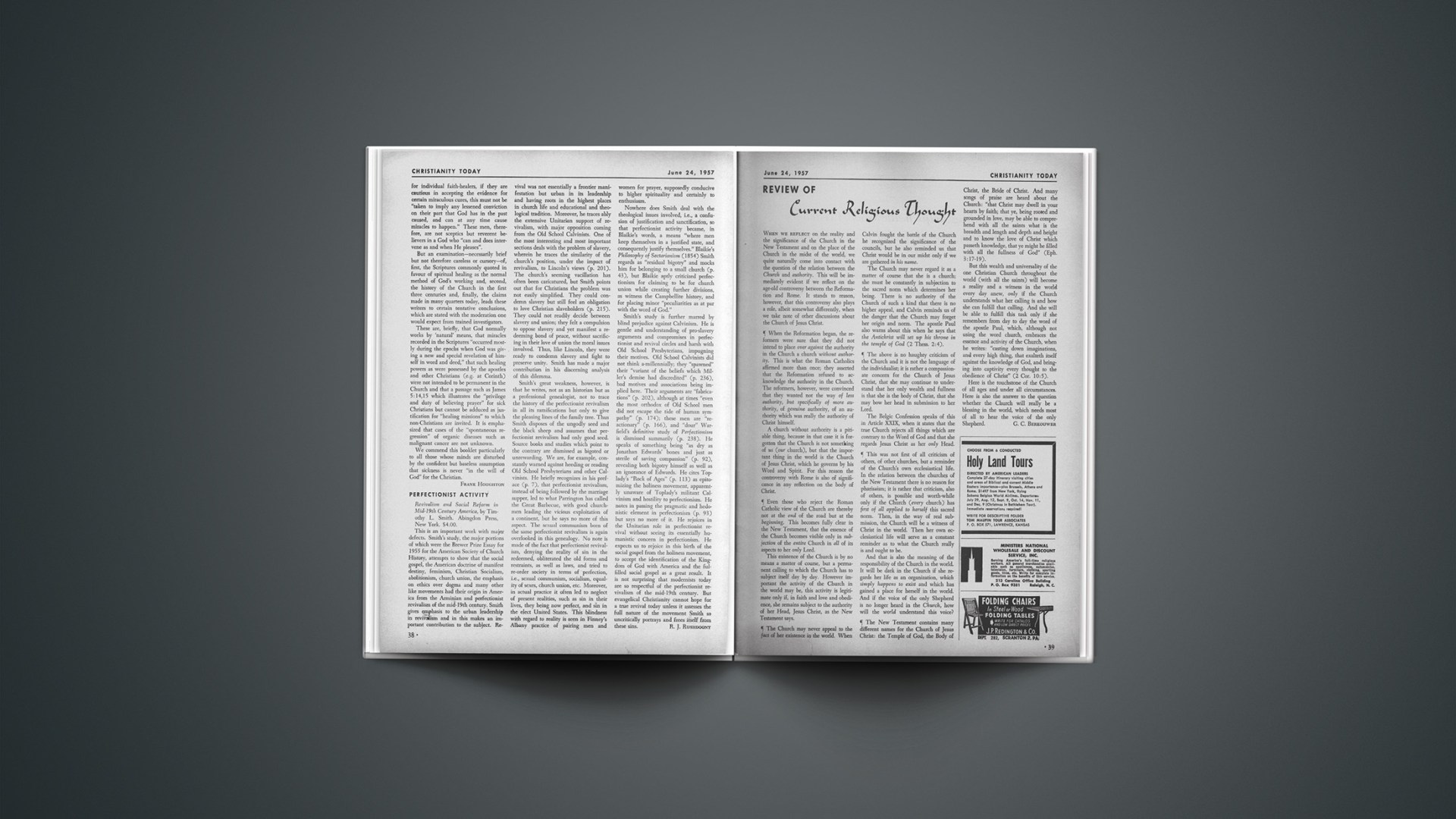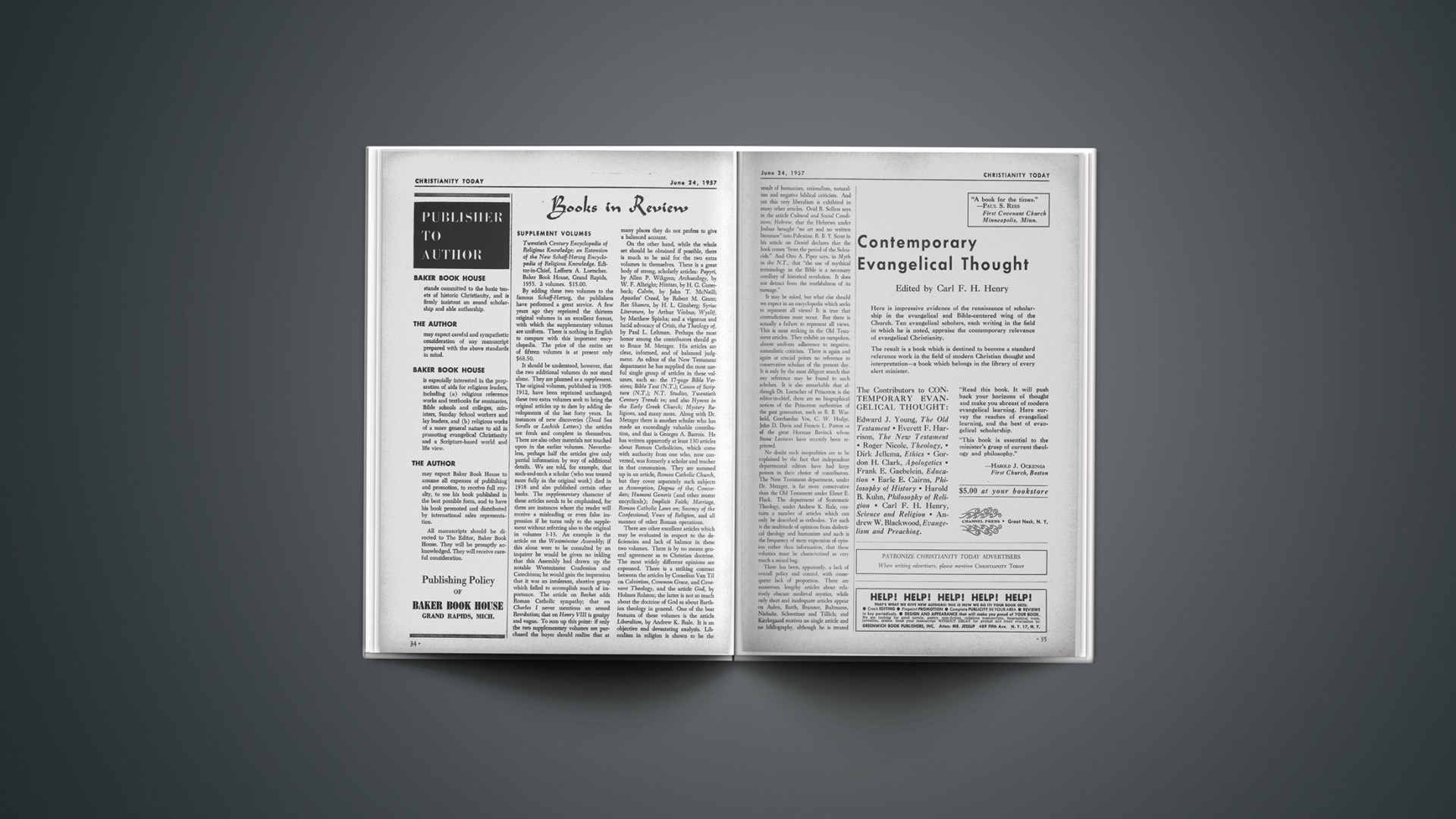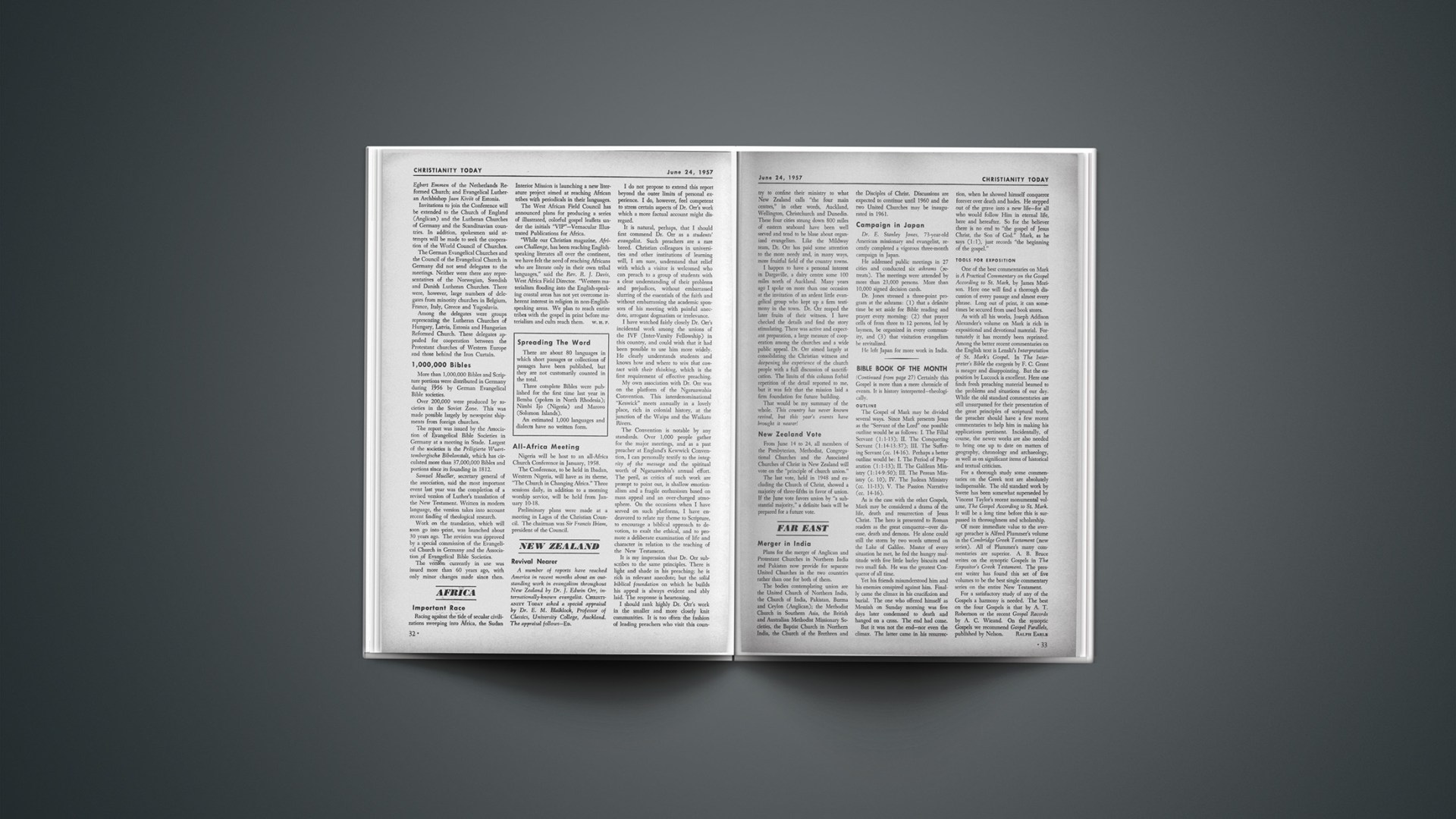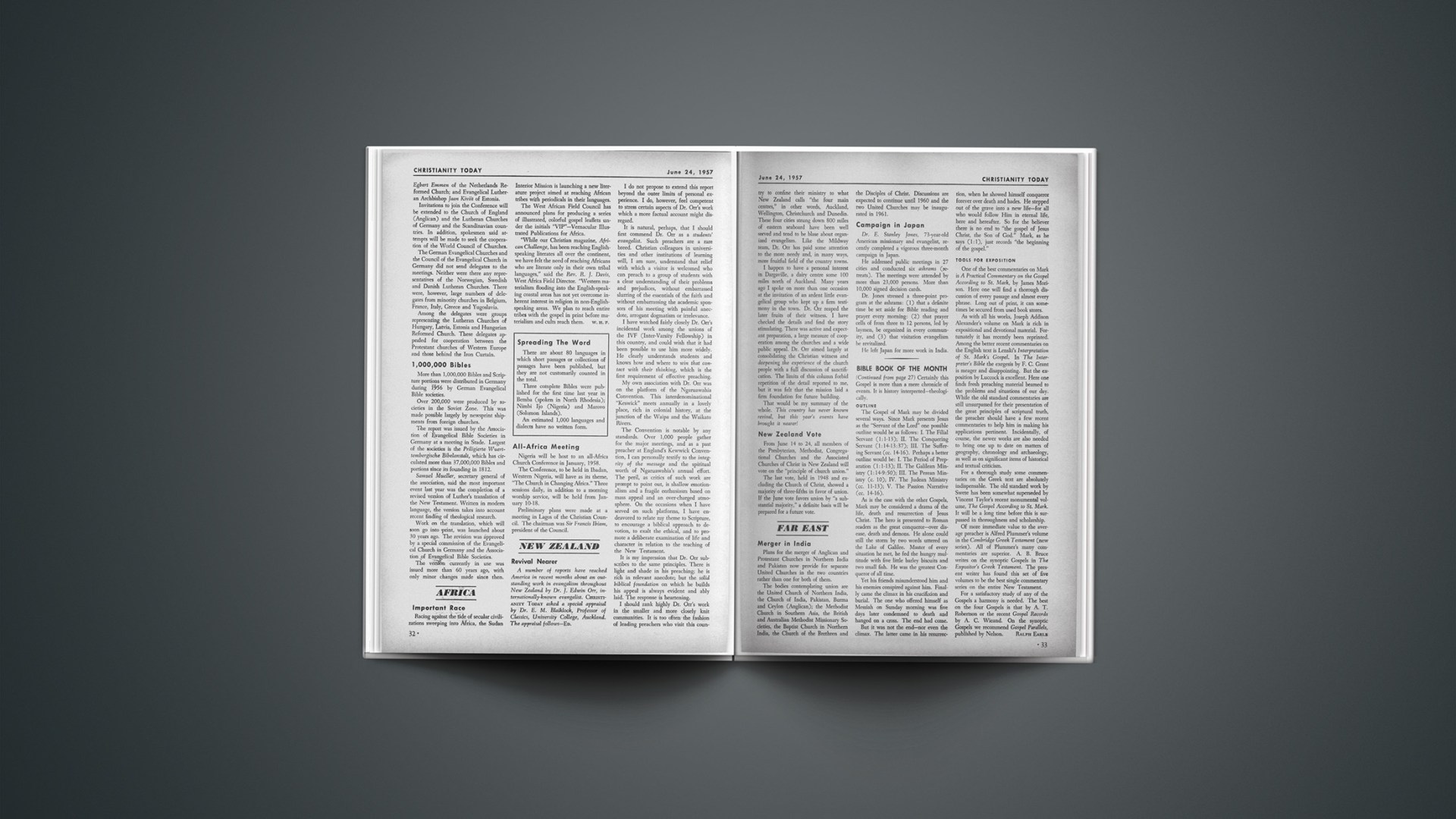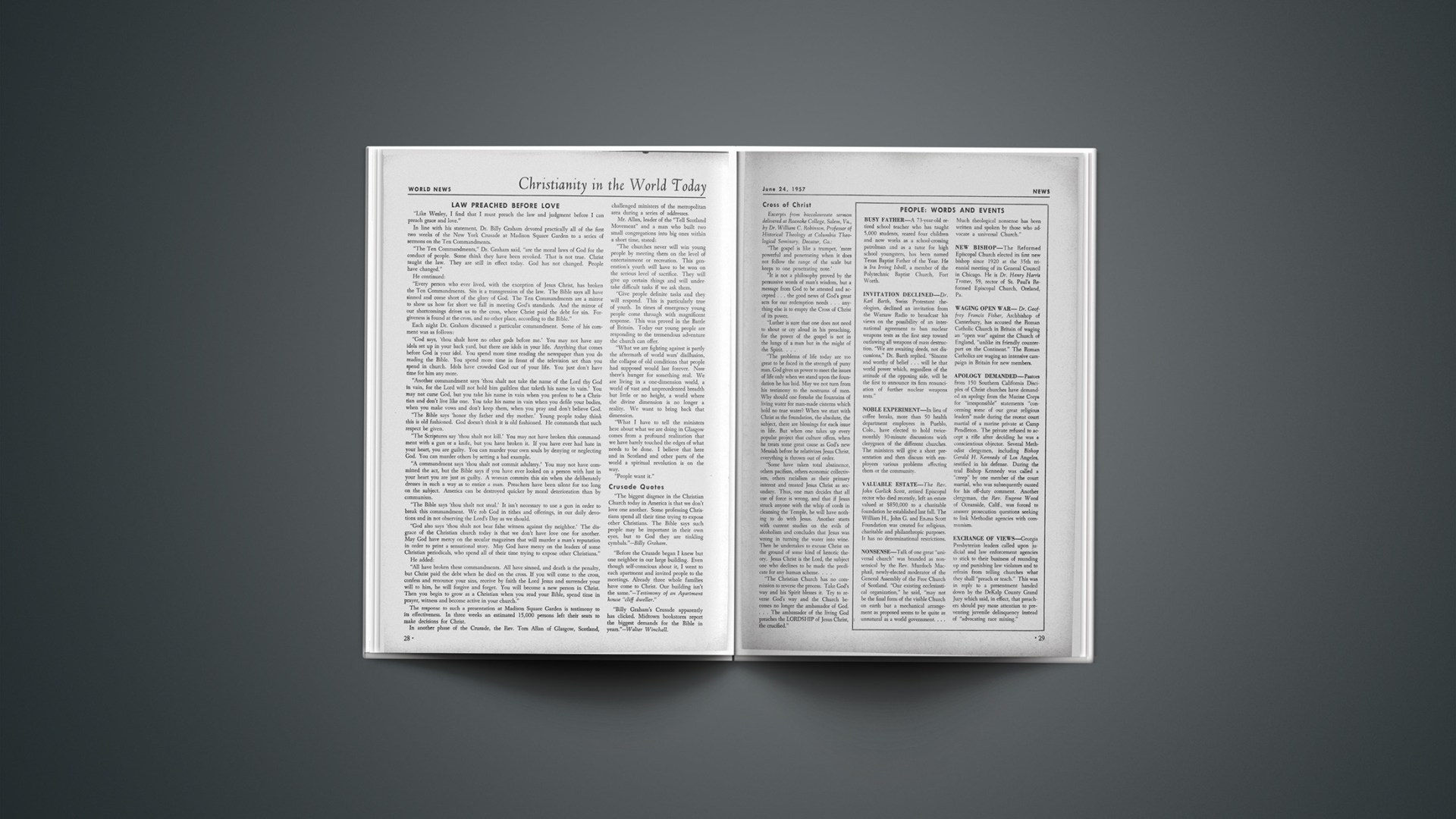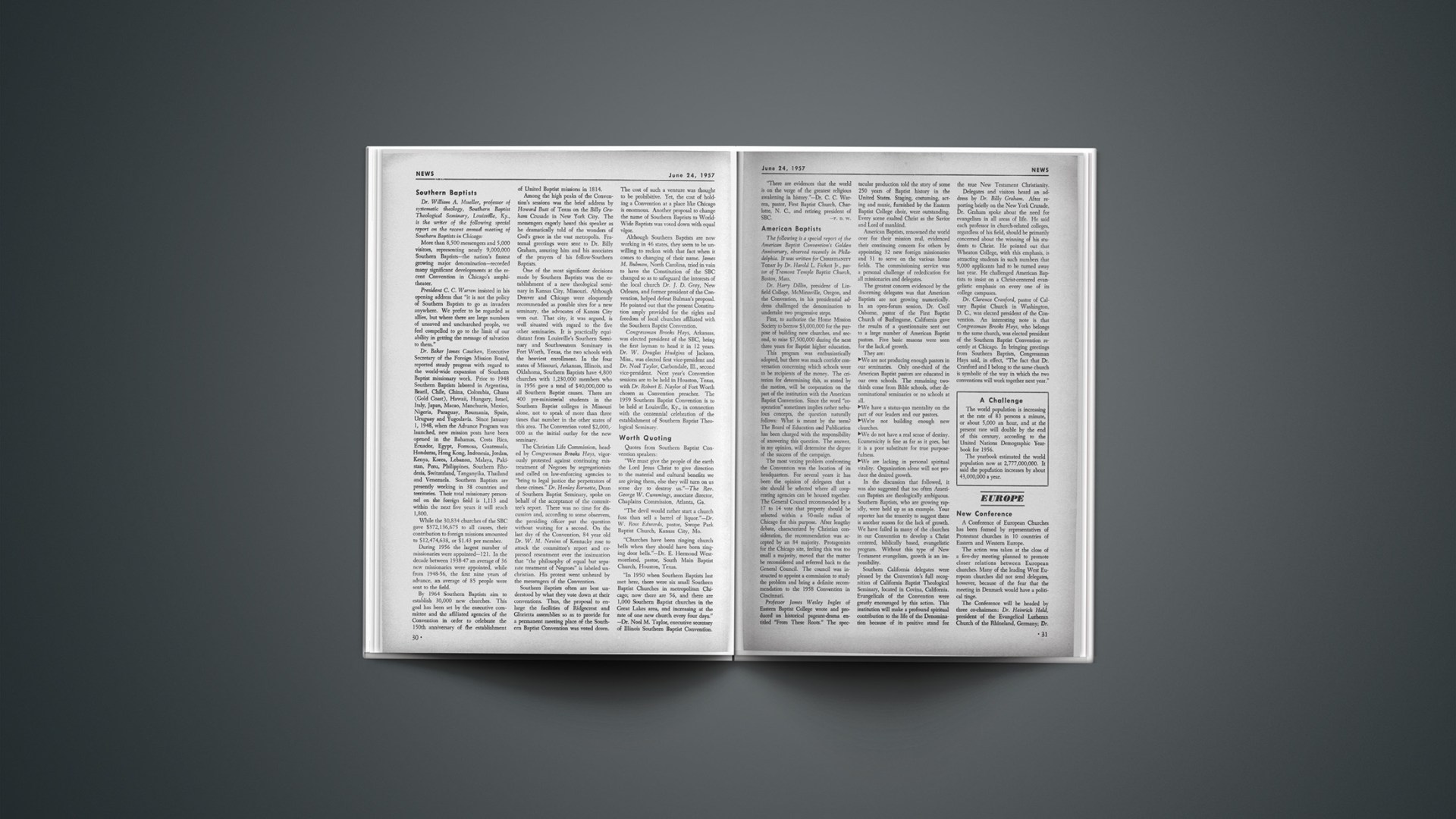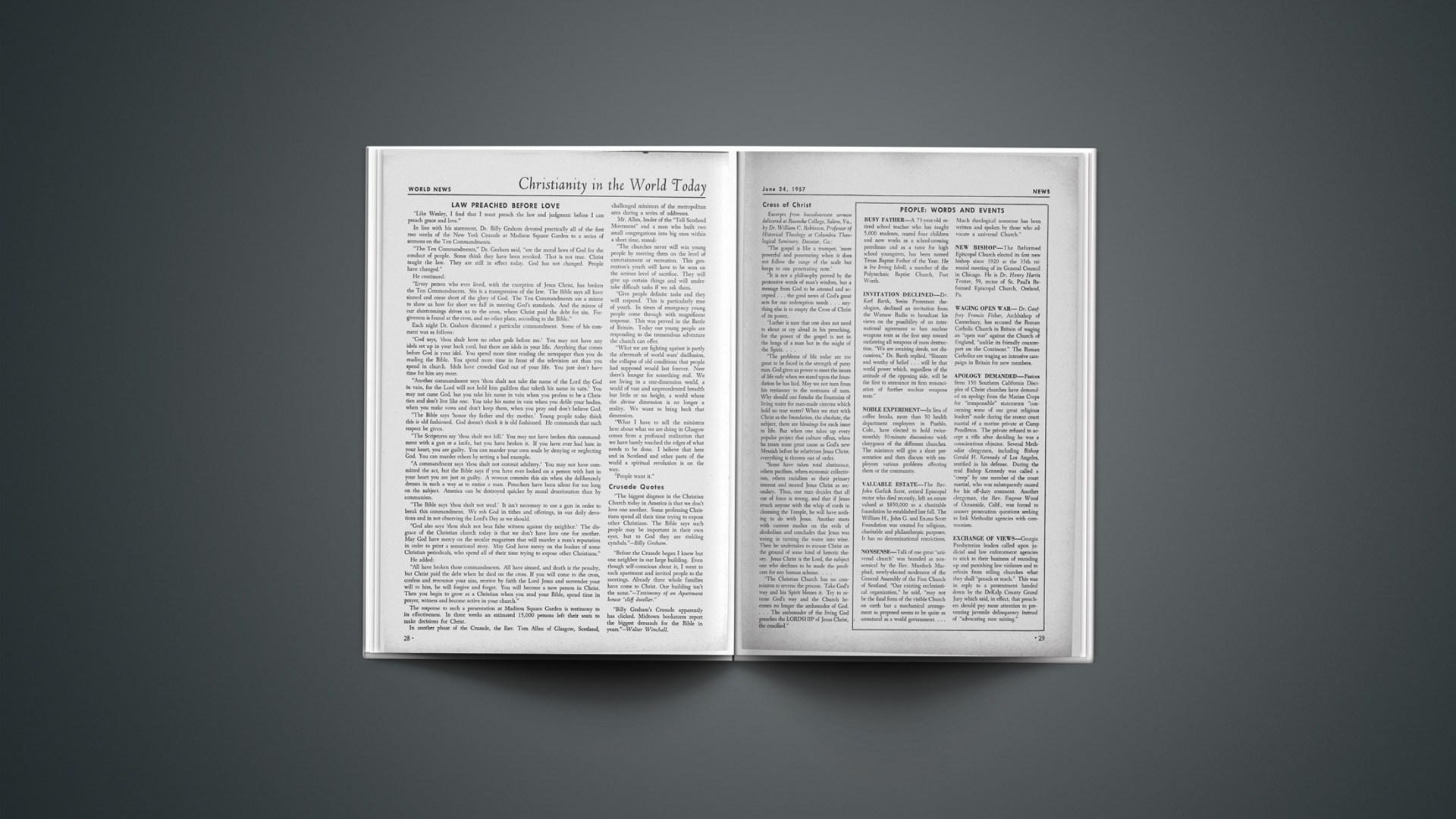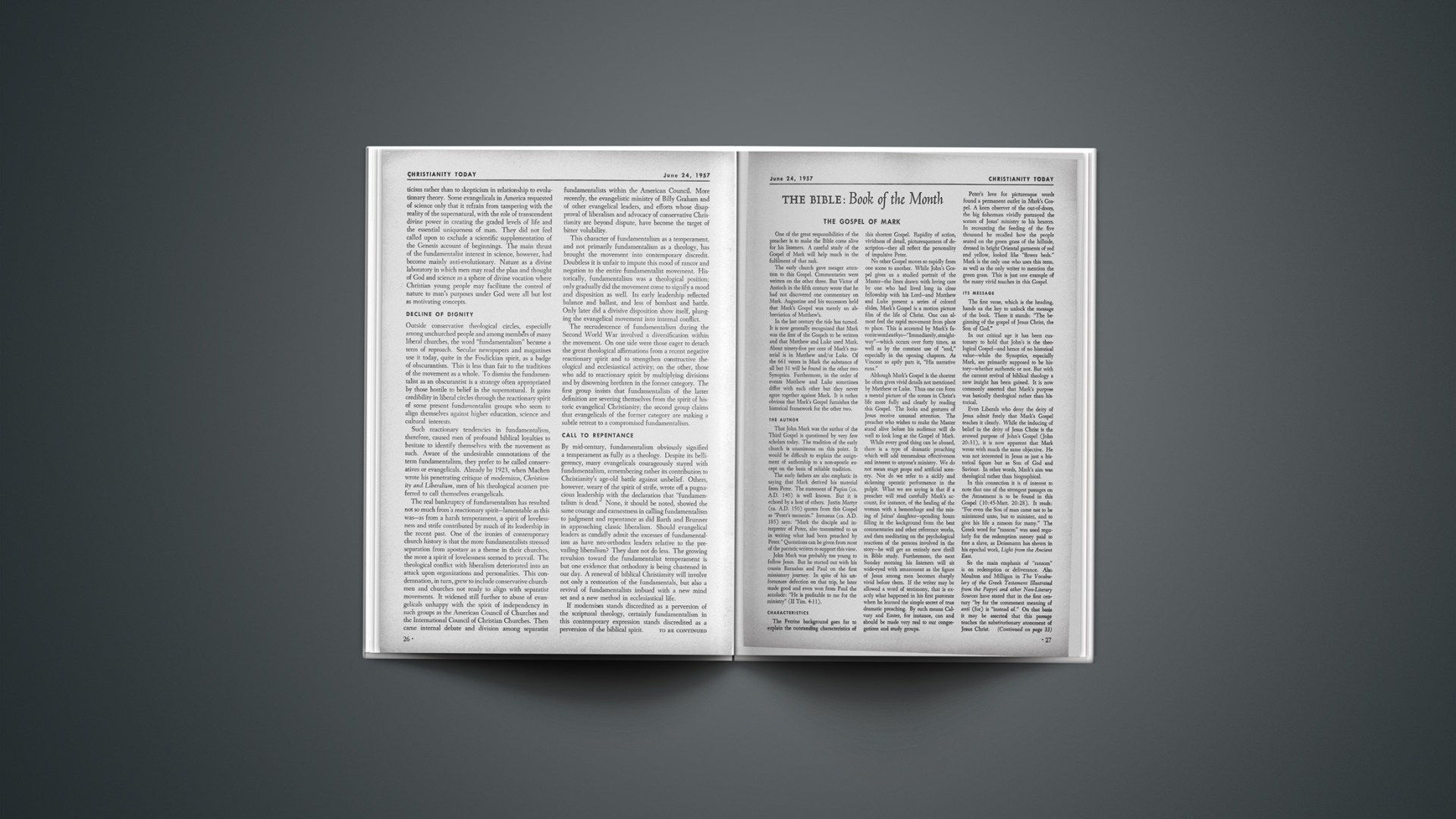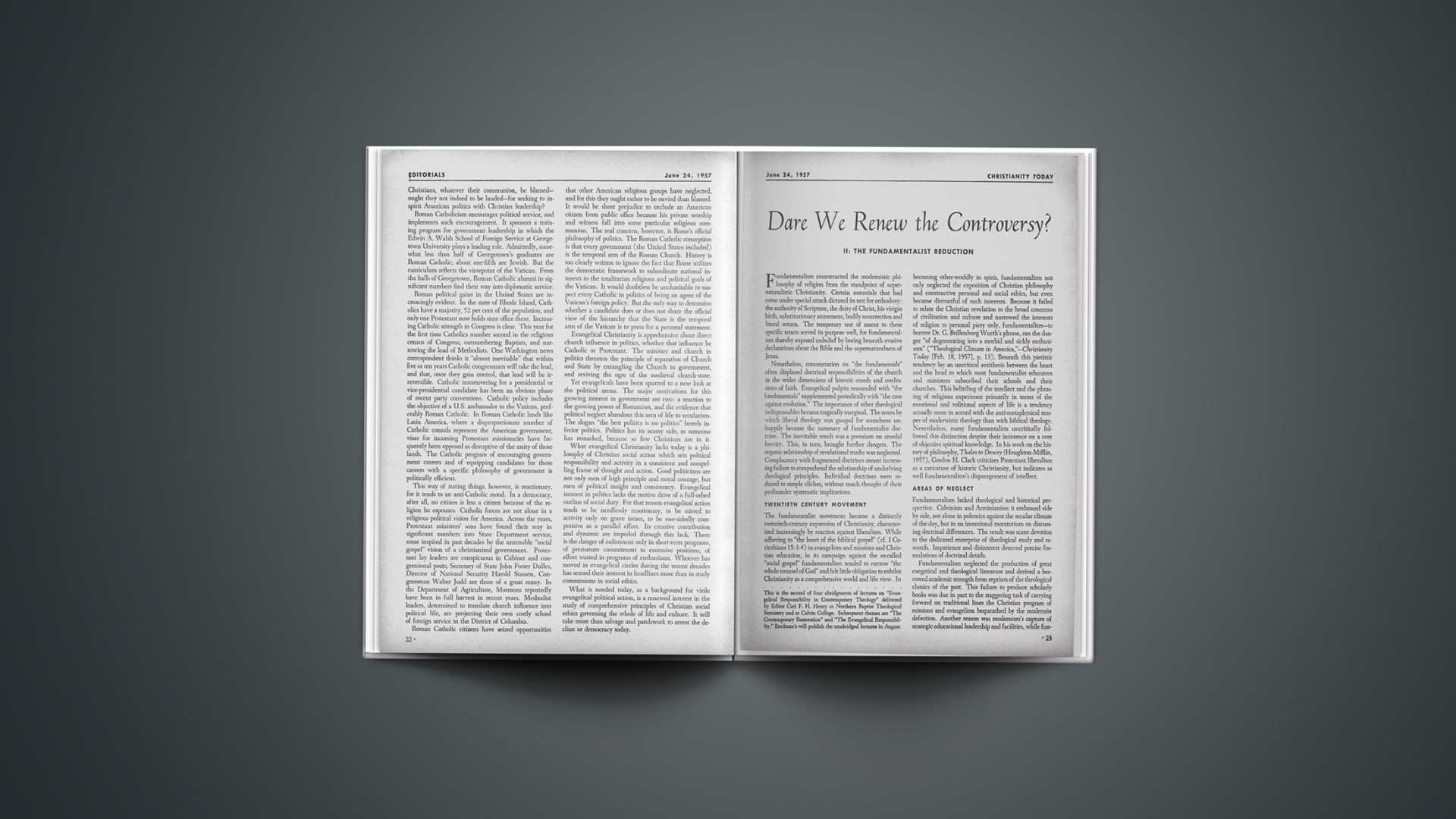“American civilization has not merely changed its inspiration and its character but its epoch as well.” Thus Andre Siegfried, one of the leading French humanists, describes the cultural revolution in the United States. For him “the epoch of the pioneer has been replaced by the epoch of the machine” (Andre Siegfried, Nations Have Souls, G. P. Putnam’s Sons, 1952, pp. 170–171). Siegfried has emphasized the obvious. He has brought into focus the everywhere-apparent emphasis upon material values—the trend toward “bigness”—the decline of the significance of the individual.
The Vision Of Life
Latent in his analysis is the thought that culture is not made up alone of what we see. It may also be found in what we dream. Culture, in the sense of life’s habits—one’s way of doing things from day to day—may vary greatly from land to land, from community to community, and even from family to family. But the real question to be fathomed is this, What is the vision of life that a people carry about in their heads? Do they think of themselves as playing a part in a dramatic conflict with forces unseen, or are they cogs, bars, endless belts in an ordered mechanized existence?
The distinctiveness of American culture lies in its “myth”—its vision of life. This picture of life is highly dramatic. It conceives of man as an individual, discreet, intelligent, purposive, active. He is part of the society yet separate from it. He possesses capacities that are comparable to his fellows but always manifests a singular uniqueness in their demonstration. He is limited by his companions, yet is not bound by them. He is buffeted by circumstances yet never defeated. He is the servant of nature and likewise its master. He is a “free” man and not a slave. He knows life in the sense of destiny and purpose.
Such a vision of life is unique. The source of its singularity is to be found in its inspiration. This is hardly in the presence of “free land” in America nor in the abundance of the natural resources of the region to which men came. Neither was it imbibed from the changing climate of this north temperate region. Rather, it is to be discovered in the religious symbolisms of the men and women who laid the cultural foundations of American society.
Puritan Influence
The early vision of life in America was strongly influenced by the Puritan. His “cultural myth” was biblically inspired. Living in a day when church and state placed great emphasis upon the principle of order and unity, the Puritan protested against the cultural dominance of these external forms. He raised his voice against this tendency to uniformity in life and boldly asserted that man was no longer to be cast in the time-honored mold of his culture. Man was to be a “free” personality who would rise dominant over his culture. The basis for such a vision? It was to be found in the biblical view of God’s redemptive work for man, and in the realization of the individual reality of this experience by an act of individual faith. Alan Simpson’s recent study, Puritanism in Old and New England (University of Chicago Press, 1955), has again brought to light the importance of this vision in the life of early Puritanism. From it came the dynamic which drove men to oppose the church, the crown, and every semblance of regimentation until men were made free.
The real basis of the Puritan protest has great meaning for our present predicament. What the Puritan saw was this, that man tends to project the cultural form of the present into the future by codifying it as natural law and by employing the organized forces of society to sustain it. This made man the creature of his culture, rather than the creator. It further tended to divorce him from the real source of cultural inspiration, namely, God, and to deprive every cultural form of its real meaning and intent. In opposition to this tendency the Puritan asserted again and again that God, alone, was lord of the conscience. This meant that man must be free to follow the dictates of his own conscience in matters of law and government as well as in religious practices and in ethics. It gave man a basis upon which to assert the value of the individual over against the values of the group. It is the source of the spirit of individualism in American culture. As such, it is most important to consider in approaching the cultural transition of our times.
A People Of Lip Service
America’s cultural problem today is the problem of a people who give lip service to a set of cultural distinctives—forms of expression, standards of life, visions of reality—which are cut off from their real essence. The transition has been slow and gradual. The concept of liberty, once grounded in the belief that man must he free for the worship of God in every phase of life, is now confused with a man’s right to express himself or some vague assumption that the public welfare will be advanced by a scarcity of legal limitation. The concept of equality, which founds its inspiration in the biblical view of man’s creation by an eternal God and man’s universal state of sin or rebellion against God, is now confounded with weights and measures of economic privilege or physical capacity. The concept of private property which was conceived as a gift or trust from God and, hence, subject to limited political control, is now viewed either as the sole bulwark against arbitrary political power (that is, a very poor substitute for God), or it is viewed as a mere matter of social convenience. The institution of the family, which was once looked upon as of divine ordination and, therefore, not subject to man’s tinkering, is now often accepted as a product of an evolving set of social relationships. The state, once conceived as an instrument of God’s justice is now decried as the instrument of man’s inhumanity to man.
How may we retain our cultural distinctiveness? The answer lies in our readiness to abandon our prophets of monism and our willingness to return to a view of culture which accepts the various orders of inspiration—the spiritual, the intellectual, the material—and place them in their proper relationship to one another in the reinterpretation of American life.
The Loss Of Balance
Cultural history in America exhibits an alarming tendency to lose that sense of balance in orders of values that is so essential to a healthful cultural life. Beginning with a vital cultural vision gleaned from the Bible and interpreted in the forms of the evangelical Christian tradition it soon began to lose its distinctiveness. Seventeenth century Puritanism with its wholesome balance of supernaturalism, rationalism, and observationalism, sat down to converse with its snake in the garden and lost its freedom to an incipient intellectualism. Roger Williams detected the transition in Massachusetts Bay and was driven into exile for his protests. It all came about in a manner quite common to men who desire to preserve a revolution through the deification of new forms of expression. In its effort to preserve the vision of the individual God-man relationship through a personal experience of saving faith, Puritanism created its own “golden chain of being”—the concept of “covenant”—to connect the transcendent with the imminent and thus to give order to this new vision of life. The concept of “covenant” viewed all of life on this earth as related to God through the Living Word, Jesus Christ, and through the inspired word, the Scriptures. These somewhat mystical forms had to be translated into concepts intellectually prehensible. Then followed the “federal theology,” the elaborate explanation of the meaning of the “covenant” concept. It brought to American culture a vision of life which has never been transcended. In it the individual was most important. All institutions were divinely ordained, but man had a coordinate responsibility for their projection and maintenance. He was given a sense of responsibility and a vision of destiny that linked him with the Eternal. But tragedy became imminent when the son of the Puritan began to worship this theological formulation which often smacked more of Plato in its manner of expression than of its biblical typology. The idea of “covenant” which was basically an idea of personal relationship and order, was reduced to a principle of uniformity, a law. The result was manifest in the eighteenth century preaching of New England which emphasized the rationality rather than the personal aspect of God’s dealing with men. To put it theologically, the “covenant of grace,” whereby God extended salvation to his elect, was by-passed for the “covenant of works—the rational explanation of God’s dealings with men as part of the whole order of nature. Man thereby lost his identity as a person, he became known only as part of a rationally conceived order of life. Man was no longer dominant over culture but had surrendered his spiritual and intellectual powers to its control. With the passing of the “covenant of grace” there was little justification for change.
Shift Of Sovereigns
It was against this transition in American culture that Jonathan Edwards thundered in the middle of the eighteenth century. Edwards was concerned that America should assert the supremacy of the will as over against the domination of the intellect. He was determined that the sovereignty of God should be restored to American culture in opposition to both the intellectualist and the romanticists. In spite of his valiant efforts eighteenth century rationalism in the form of Deism wrought significant alterations in the American cultural myth. God, the Creator, still remained as the author of all order and truth. But the “golden chain of being,” the mediator between God and man, was no longer Christ and the Scriptures. It was Nature, conceived in the ordered vision of Newton’s Principia. The scientific experiments of Franklin and the writings of Jefferson and his friends tended to reinforce, yes, even to deify this concept. There had been brought back into American culture the principle of uniformity under the guise of science.
It was in the light of such a vision that Jefferson stated the basic principles of the American creed. These great ideas of equality, rights, and happiness were traced to “Nature’s God,” not the God of nature. In so grounding them Jefferson laid the basis for our cultural confusion. The modern conflict with atheistic materialism has demonstrated that there can be no “scientific” justification for such concepts. Man cannot look upon them as intellectual abstractions alone; they must be accepted as divine imperatives that are essentially spiritual in nature and can be understood only in the light of a Divine Creator who is also a Divine Redeemer. This is what Jefferson left out. Since then we have been trying to shore up the foundations of our cultural forms with new types of scientifically drawn intellectual abstractions only to discover that they are insufficient.
Distinctives In Peril
From the vantage point of the mid-twentieth century it is now possible to see quite clearly what happened to American culture in the nineteenth. Transcendentalism sought to perpetuate a basis of uniformity in the cultural myth that was not dependent upon human experience. God, in Emerson’s concept of the “Over Soul,” would transcend finiteness and thus give stability to culture. But there was something lacking, the sense of tragedy, the presence of sin. The vision became optimistically rigid. There was no deviation from the path of progress in the pattern of change. This vision served to strengthen the American vision of destiny and to awaken the social conscience to the enormities of human slavery. But the dynamic of action for the reform movement which followed sprang from the vision of God and man which burst upon the American scene in the Finney revivals.
Simultaneously, another movement sought to restore the concept of grace, of needed change, in the American cultural myth. Having rejected the vision of revelational grace which moved the Puritan Jonathan Edwards, and Charles G. Finney to clamor for reform, the new prophet sought inspiration from the scientific doctrines of change which were then emerging. The evolutionary view of life—dialectical, survivalistic, or emergent—became the inspiration for the American dream. God became imminent in the very motion of matter. In fact, there was no need for any transcendent God or any absolute; all that was necessary was the ability to determine the trend of the motion. This would provide the oracle for man’s action, the vision for his dream.
It is quite obvious that this tendency to monize our cultural inspiration does violence to the basic constructs of knowledge itself. Long ago the Greeks laid it down that all knowledge deals with origins (being), behavior (becoming), and ends (telesis). Our latest cultural inspiration has been drawn from behavior, alone. We have tried to explain both origins and ends in terms of behavior. We have lost the sense of balance and completeness which comes when one recognizes that both origins and ends are to be interpreted in terms of revelational truth. This places our absolutes where they belong—in God. It saves us from the error of confusing our ideas about God with absolutes, that is, it places rational truth in its proper place—namely, as one form of understanding. Likewise, it helps us to recognize that the knowledge derived from experience is meaningful only as it demonstrates in a non-deductive manner the realities of the absolute.
The American cultural myth is a rich one because of its basic inspiration derived from the person of God. It is sound when rational truth is brought into conformity with this “heavenly vision.” It is real when it permits man to experiment and to learn more of life through the realm of experience. This balance of the spiritual, the intellectual, the experiential, is the genius of American culture. When we lose this balance and endeavor to project either the principle of order, rationality, or the principle of change, experience, as the basis of our culture, we lose the proper foundation for any sound cultural system. We then become slaves either to the “god” of our intellectual abstractions, or of our observational generalizations. We can know freedom in our culture only as a free God is posited as its base. Without this assumption America will continue to lose her cultural distinctives.
END
We Quote:
DANIEL A. POLING
Editor of “Christian Herald”
Why do we support Billy Graham and the New York Crusade? Because he speaks always for Jesus Christ, because always his message is Christ-centered, because always he preaches Jesus Christ as man’s only sufficient Savior, because always he is a proved open channel for the Holy Spirit, because always he honors the Bible as the inspired word of God, and because under his leadership the churches of our Protestant faith are united in a Crusade unequaled in the history of this vast city.… The negative critics of the Billy Graham Crusade and of mass evangelism ask the question: Did Billy Graham change London and Glasgow?… The records indicate that large numbers of the converts do stand fast. But if the final test be thus raised, what about the entire history of Christianity since St. Peter preached at Pentecost?… What about John Wesley and Dwight L. Moody and all those other humble but inspired men who went before or who have come since? Is not Christianity itself and all that is worthy in the ecumenical movement of our time, the direct result of evangelism, mass evangelism included?
S. Richey Kamm is Chairman of the Division of History and Social Science at Wheaton College in Illinois. He holds the A.B. degree from Greenville College, A.M. from University of Michigan, and Ph.D. from University of Pennsylvania, and in 1952 was awarded the LL.D. degree by Seattle Pacific College.

